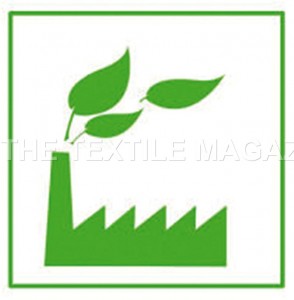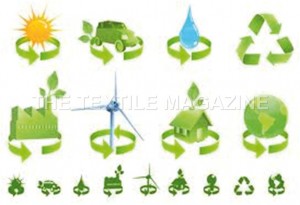From the clothes we wear to the curtains in our homes, thousands of everyday items we rely on are produced by the textile industry. However, dyeing and finishing of one ton of fabric with lots of harmful chemicals can result in polluting up to 200 tons of water. It also involves consumption of a tremendous amount of energy for steam and hot water. With the industry mostly concentrated in countries still developing environmental regulatory systems, such as China, India, Bangladesh and Vietnam, textile manufacturing causes environmental degradation.
However, dyeing and finishing of one ton of fabric with lots of harmful chemicals can result in polluting up to 200 tons of water. It also involves consumption of a tremendous amount of energy for steam and hot water. With the industry mostly concentrated in countries still developing environmental regulatory systems, such as China, India, Bangladesh and Vietnam, textile manufacturing causes environmental degradation.
To address the rapidly deteriorating environment at the global level caused by the textile industry, voluntary organisations, along with a group of apparel retailers and brand partners, have come up with a few initiatives to curb pollution in the sector while saving the industry money. This initiative does not call for large-scale retooling of the textile industry but easy-to-implement and low-cost opportunities that pay for themselves in less than a year.
SRF Industries
 SRF Industries, as a group, has grown into a global entity with operations in four countries. Apart from its leadership in technical textiles business, the company is a market leader in refrigerants, engineering plastics and industrial yarns as well. It also enjoys a significant presence among key domestic manufacturers of polyester films and fluoro specialities. Building on its in-house R&D facilities for its technical textiles business, it strives to stay ahead in business through innovative operation and product development.
SRF Industries, as a group, has grown into a global entity with operations in four countries. Apart from its leadership in technical textiles business, the company is a market leader in refrigerants, engineering plastics and industrial yarns as well. It also enjoys a significant presence among key domestic manufacturers of polyester films and fluoro specialities. Building on its in-house R&D facilities for its technical textiles business, it strives to stay ahead in business through innovative operation and product development.
SRF is of course conscious of the challenges of operating in a highly competitive environment. Since the technical textile segment contributes to over 50 per cent of its turnover, the company has implemented a few energy saving practices in this segment to further reduce its operating cost.
At its Kashipur technical textile facility, the company saved 37,440 kwh of power in 2012-13 by switching off one of the two dust collectors and by shifting it nearer to the dust generating area. It saved 1,37,808 kwh per annum by installing the variable frequency drive (VFD) in the 55 KW thermal fluid heater (TFH) circulating pump. It also was able to retain 31.2 tonnes of furnace oil during the year by installing an air pre-heater (APH) in the TFH.
Further, the company could manage to save 28,224 kwh of energy by replacing three high wall split air-conditioners with chilled water-based air handling units (AHUs) in the same period.
At its Manali unit, in Tamil Nadu, SRF enhanced the capacity of the cooling tower pump to 90 kw and stopped operating two pumps  with 75 kw and 55 kw power. By doing so, the unit was able to save 17,166 kwh a month. Isolation of loom air supply during stoppage of loom for more than five minutes could reduce its energy consumption to 6,666 kwh a month. Automatic switch-off of the motor in the drapper loom during loom stoppage for more than five minutes resulted in a monthly saving of 12,500 kwh of energy. An inverter provision for K1 air compressor to control the loading based on HP air pressure reduced monthly energy consumption by 8,333 kWh. The unit was also able to save 2,416 kwh of energy by running air washers instead of AHUs during winter.
with 75 kw and 55 kw power. By doing so, the unit was able to save 17,166 kwh a month. Isolation of loom air supply during stoppage of loom for more than five minutes could reduce its energy consumption to 6,666 kwh a month. Automatic switch-off of the motor in the drapper loom during loom stoppage for more than five minutes resulted in a monthly saving of 12,500 kwh of energy. An inverter provision for K1 air compressor to control the loading based on HP air pressure reduced monthly energy consumption by 8,333 kWh. The unit was also able to save 2,416 kwh of energy by running air washers instead of AHUs during winter.
The Viralimalai unit of SRF has improved its fuel consumption by installation of energy-efficient DGS and by replacing mercury vapour lamps with LEDs. The unit achieved a monthly saving of 1,000 units by introducing the load energy saver in the warp twister. A timer-based controller was provided in the HSD cooling tower motor which reduced 600 kwh a month.
At the Gwalior facility of the company energy efficiency was achieved by switching off idle transformers and installing energy-efficient lamps and pumps. The unit also saved 30 kw per hour by installing an energy-efficient PSA nitrogen plant and another 18.6 kw per hour by installing FRP boxes in the Toray twister motor exhaust system.
SRF’s Gummidipoondi technical textile unit achieved a saving of 12,200 kWh a month by optimising operation of the HT & LT air compressors and by reducing the air pressure at the dipping and nitrogen plant at 7 kg per sq. centimetre instead of 9 kg. Energy consumption was also reduced by 2,520 kwh a month by lowering the suction gun air pressure of 15 kg per sq. centimetre to 14 kg.
A monthly saving of 3,289 kwh was recorded by reducing the speed of the cooling tower fan. This helped save fuel consumption and cut the operating cost.
KPR Mills
 KPR Mill Ltd. specialises in readymade knitted garments, knitted fabrics and cotton yarn, including value-added compact and melange yarn. It has its state-of-the-art production facilities in and around Tirupur.
KPR Mill Ltd. specialises in readymade knitted garments, knitted fabrics and cotton yarn, including value-added compact and melange yarn. It has its state-of-the-art production facilities in and around Tirupur.
The company has its high priority to energy conservation schemes and takes effective steps to implement them wherever possible. Energy saving continues to be the thrust area for the management which keeps studying newer methods to achieve it.
At the company’s Karumathampatti spinning unit, the old belt-driven reciprocating type compressor has been replaced by the Atlas Copco screw compressor with inverter drive to avoid belt transmission loss and increase the output efficiency in the air line system. The variable frequency drives installed in the WRS centrifugal 75 kw motor with pressure controller to maintain the required pressure consistently by varying speed have been modified by draft air technologies.
At the compact spinning unit, the company has installed variable frequency drives in the spinning blower motors and humidification plants to optimize the energy output by maintaining the required machine parameters and department relative humidity. The existing fans in the overhead cleaners have been replaced by energy saving ones in all 72 ring frames.
At its Neelambur plant, a lighting energy saver unit of Beblec make has been installed for total lighting system, and significant saving has been achieved in overhead travelling cleaners by optimizing the hours of operation.
At the Arasur unit, all the frames pneumatic suction tubes have been modified to improve the suction level and simplex OHTC operations controlled based on machine running by timer controls.
At the Sathyamangalam unit, significant energy saving has been realised in the lighting system by replacing most of the old conventional ones.
Gokak Textile Mills
Gokak Mills, a part of the Shapoorji Pallonji Group, was established in 1885. Gokak initially set its pace for developing yarns for handlooms and then entered into tyre cords, best quality industrial yarns, weaving and knitting yarns catering to worldwide markets.
The century-old company has one of the most modern mills in the country which have diversified into producing dyed yarns, canvas, terry towels, knitted garments and other downstream products. Since inception, the company has always taken forward its business with a concern for nature and environment by contributing its part of energy saving.
In 2012-13, the rearrangement of blow room waste evacuation system in its mill seven enabled considerable power saving to the company. Auditing of pulleys in the autoconer machines and proper machining in workshop has enabled reduction of load on motors of Savio autoconers.
The company had rearranged the power capacitors near load centres and replaced the derated capacitors. It had overhauled, lubricated and replaced old inefficient bearings by new ones in all DJ5 ring frame machines in its mill two. In the humidification plant the blade angle of the supply air fan was changed in order to reduce the load on the fan motors. It was also able to estimate the quantity of air leakage by installing a rotameter and accordingly was able to arrest leakage in all autoconers. All these efforts improved the energy efficiency of Gokak Mills and helped to achieve cost effectiveness.
Investment plans
For 2013-14, Gokak Textile Mills has investment plans for provision of front stop motion in speed frame machines and enable stopping of pneumafil fan motors to save power. A frequency converter to be provided in pneumafil fan of ring frame machines. Automatic power factor control panels (APFCs) are to be installed and some existing manual APFC panels to be converted to auto mode.
The company plans to introduce lower dia suction tubes in these machines. Refurbishing of 224 kg dyeing machine shall be undertaken which enables it to improve its efficiency. Rearrangement of power feeding shall be done from grid power house to mill two by increasing the cross section.
The company also plans to install power transformers nearer to load centres for mills 1, 2 and 3.
Mafatlal Industries
Mafatlal Industries Ltd., one of India’s largest textile manufacturers, has an extensive range of products comprising a cumulative sale  of over 80 million metres per annum. The company offers a wide range of fabrics (suiting and shirtings, twills, voiles, prints, poplins, cambrics, fine lawns, school uniforms, corporate and institutional wear, bed and bath linen, among others, in polyester or viscose and polyester wool blends), speciality fashion denims and readymade garments. The company produces some of the finest fabrics in the country in a count range of 7’s to 140’s, addressing the needs of some of the most demanding customers in India and abroad.
of over 80 million metres per annum. The company offers a wide range of fabrics (suiting and shirtings, twills, voiles, prints, poplins, cambrics, fine lawns, school uniforms, corporate and institutional wear, bed and bath linen, among others, in polyester or viscose and polyester wool blends), speciality fashion denims and readymade garments. The company produces some of the finest fabrics in the country in a count range of 7’s to 140’s, addressing the needs of some of the most demanding customers in India and abroad.
Energy efficiency has been the textile major’s prime focus to achieve cost effectiveness. In 2012-13 the company installed stop motion sensors in six of its speed frame machines and SITRA fans which save energy. The compressed air management program (CAMP) by ‘SYSTEL’ helped in energy efficiency of air compressors by reducing its air leakages. Humidification costs were reduced by rationalizing ring frame locations.
The capacity of the Atlas Copco compressor cooling tower water circulation pump motor was reduced from 11 kw to 5.5 kw. The company installed a 2HA2QT Kirloskar reciprocating compressor of 90 kw motor in place of an old lubricating compressor of 132 kw motor. A system for water recovery from cooling system of Sanforiser was also installed. Air dryers of compressors have been modified resulting in lower consumption of power.
Power consumption in the effluent treatment plant was reduced by adopting the bubbling system in place of the surface aeration technology. Systems and equipment at the demineralised water plant (DM) were modified to recover water for reuse.